6 Best Infection Control Products To Know
Risk recognition involves visualizing the possibility of a crisis emerging, and preparing for it accordingly. This is the essence of infection control products, and below are the six best that you’ll always want to have in your possession.
Personal Protective Equipment
Facial masks form a key component of PPE, and consumers have the option of purchasing masks that are reusable (that use disposable filters) along with disposable facial masks, which can be effective both in industrial and healthcare settings. The highest quality masks have been extensively tested to ensure dependability.
Disinfectants
HLDs, or high-level disinfectants, are utilized to eradicate the majority of microorganisms in biosensors and surgical tools. In the event that audiology equipment or instruments are damaged as a result of autoclaving, these chemical products are indispensable, with two of the most popular chemicals being Rapicide or OPA (Ortho-phthalaldehvde).
Sterilization Trays and Baskets
These are the perfect tools for storage. Sensitive surgical equipment must be carefully stored and wire baskets along with sterilization trays provide outstanding structural integrity. They are also well suited to transport, handling, sterilizing and washing.
Instruments Protection
This product will assist you in caring for and maintaining essential surgical tools and equipment. This is accomplished through the usage of complex enzymatic detergent proteolytic action, which will break down the biological contaminants. They can also function as stain removers as well as lubricants and rust inhibitors.
Cleansers and Sterilizers
Those that need to disinfect, clean, or sterilize their surgical tools will benefit greatly from cleansers and sterilizers. These products come in many forms which range from instrument storage to sterilization trays, wire baskets, UV sterilizers, ultrasonic cleaners and trays which are fully micro-perforated.
Detergents
Proper instrument care can be divided into three steps, which are cleansing, disinfection and sterilization. Detergents play a key role in this process, as they will eliminate biological material, debris and dirt which are present on surgical tools, and are also designed with enzymatic components which can be applied to biosensors as well.
Why is Infection Risk Recognition So Important?
The likelihood of germs spreading within medical care facilities is much higher than in other places because this is the place where sick people come for help. As a consequence, healthcare practitioners come in close proximity to such individuals and must protect themselves as well as their patients and the public in general.
To combat infection and prevent its spread, healthcare workers must recognize germ behavior and adhere to procedures designed to control it. For instance, germs commonly reside in places such as the respiratory tract, skin, blood and gut, as well as on dry surfaces, wet surfaces, devices and within dust or dirt.
Germs can be easily transmitted from one place to another, usually through touch, inhalation, bodily fluids and water or liquid sprays. While the human body has natural defenses designed to repulse them, this can be easily bypassed during surgical operations. This is why medical facilities must take stringent actions to recognize and control infection risk while adhering to both state and federal regulations.